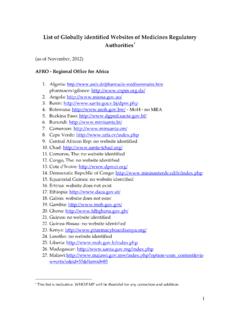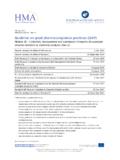Transcription of WHO DRUG INFORMATION
1 WHO drug INFORMATION VOLUME 14 NUMBER 1 2000 RECOMMENDED INN LIST 43 INTERNATIONAL NONPROPRIETARY NAMES FOR PHARMACEUTICAL SUBSTANCES WORLD HEALTH ORGANIZATION GENEVA 1 WHO drug INFORMATION Vol. 14, No. 1, 2000 General Policy IssuesThe benefits and risksof self-medication*It is widely accepted that self-medication has animportant role to play in health care and, with thecontinued improvement in people's education,general knowledge and socio-economic status, self-medication has been successfully integrated intomany health care systems throughout the products are those not requiring amedical prescription and which are produced,distributed and sold to consumers for use on theirown initiative.
2 Responsible self-medication can beused to prevent and treat symptoms and ailmentsthat do not need medical consultation or reduces pressure on medical services, espe-cially when these are limited. For those populationsliving in rural or remote areas where access tomedical services may be difficult, patients are ableto control their own conditions to a greater if the condition fails to respond, persists, orbecomes more severe will the patient need to seekprofessional medical factors have also contributed to prescriptiondrugs being deregulated to over-the-counter (OTC)sale and new drugs with specific pharmacologicalaction have been successfully reclassified fromprescription to non-prescription status in manycountries.
3 For example, in the United States ofAmerica, products containing over 80 active ingre-dients of different therapeutic groups were switchedfrom prescription-only to OTC status between 1976and 2000. In many cases, restrictions imposed onreimbursement of prescription drugs have providedthe impetus for authorities to evaluate andderegulate self-medication products to OTC many countries categorize medicines aseither OTC or prescription-only, research dataindicate that sale of self-prescription products ( prescription-only drugs without a prescrip-tion) is far more common than sale of OTC is a reality that medical personnel are in veryshort supply in many parts of the world and legisla-tion is lacking.
4 Also, the cost and time of visiting alicensed medical practitioner may seem prohibitivefor many patients if they do not consider the illnessor condition serious to a consumer interview study carried outin six Latin American countries, only 34% of dis-pensed medicines were classified as OTC (1). Itwas concluded that a relatively high percentage ofdrugs were being dispensed without medical pre-scription or follow-up and this was attributed to lackof access to medical care. Of equal concern is thefact that, in many countries, although OTC medi-cines are provided with a patient INFORMATION leafletthe self-prescriber does not receive any informationwhatsoever on how to use a prescription , it is the increase in competitive pro-motion of self-medication products which hasenhanced consumer and patient awareness of theavailability of products.
5 Worldwide promotion andcross-border sale of medical products via theInternet is another factor affecting consumer behav-iour which is set to boost demand. Already, theInternet offers a considerable amount of websitespromoting mail order pharmacies (as of 7 May2000, a count using the search engine Yahooidentified 16 966 and WebCrawler identified244 546). Many of these sites are not secure interms of guaranteeing the safety and quality of theproducts. However, there is no doubt that in thefuture self-prescription product sales through theInternet will increase enormously. This could createadditional demand to switch prescription productsto OTC , there are several critical issues that mustbe explored before promoting the potential benefitsof self-medication.
6 Any self-medication productshould be safe for use. This implies the availabilityof appropriate consumer INFORMATION and avoidanceof any delay in diagnosis and treatment of diseasesnot suitable for self-medication. Furthermore, self-medication drugs are known to interact with manyprescription-only drugs, alcohol and foods. How caninteractions be avoided in the event of self-medica-tion? Unfortunately, before making out a prescrip-tion, many doctors do not enquire whether patients* Based on a presentation given by Dr Lembit R go, Coordi-nator, Quality Assurance and Safety: Medicines, WorldHealth Organization, Geneva, to the First Latin AmericanWorld Self-Medication Industry (WSMI) Conference: "Rec-ognizing and Developing the Vital Role of Responsible Self-medication in Latin America", 29 31 March drug INFORMATION Vol.
7 14, No. 1, 2000 General Policy Issuesare also using self-medication products. Addition-ally, promotional messages through the media andthe Internet tend to convey a feeling of confidencein the safety of the product and often give theimpression that self-medication products are justanother consumer article. In other cases, excessiveor non-medical use may be a problem. Reportshave been received of OTC medicines being mis-used by drug addicts (2) and, according to a recentstudy in Northern Ireland, pharmacists admit thatOTC drugs may be used in this way (3).There are several critical issues involved beforedeciding if drugs should be authorized for self-medication. First and foremost, is the principle thatno drug is absolutely safe prescription drugsremain potent medications.
8 Self-medication is, inthe majority of cases, applied without medicalsupervision and, to a certain extent, is an unchartedarea with regard to interactions, pregnancy, lacta-tion, use in children and the elderly, driving, workingconditions, alcohol, or food compared to the morecontrolled prescription-only environment. In manycountries, the possibility of reporting adverse drugreactions (ADR) to self-medication products is notavailable since many conventional ADR reportingschemes operate through health care profession-als. Only in a small number of countries with highlydeveloped ADR systems are patients and consum-ers able to report ADRs directly to the authorities orthrough pharmacies.
9 Moreover, clinical trial data forprescription use may not necessarily be valid forself-medication. This situation is beginning toimprove within some countries that now demandOTC-environment studies to be undertaken mention should be made of the heavy re-liance placed on OTC analgesics. These have longbeen associated with chronic renal failure. Manyearlier reports implicated phenacetin-containinganalgesics as the risk factor. Since the early 1980s,several case-control studies have reported associa-tions between chronic renal failure and use of otherforms of analgesics, including paracetamol, aspirin,and other nonsteroidal anti-inflammatory drugs(NSAIDs). Although findings from these studiesshould be interpreted with caution, the use of OTCanalgesics is widespread and the potential impactof these drugs on the development of chronic renalfailure may be significant (4).
10 Furthermore, theconsumer may be unaware that several productswith different brand names and for different indica-tions may contain the same active need independent INFORMATION to en-sure the safe, effective and rational use of drugs inself-medication. Advice to the consumer/patientshould include a description of how to use theproduct without medical supervision and the cir-cumstances in which referral for medical advice isnecessary. In many cases, self-medication productsare also understood to mean alternative medicines,food supplements, vitamins, herbs or other sub-stances contained in commercially available prod-ucts. Many are also sold in pharmacies or healthfood stores and have not been clinically tested anddo not have a scientific basis for their recom-mended medicinal use.












